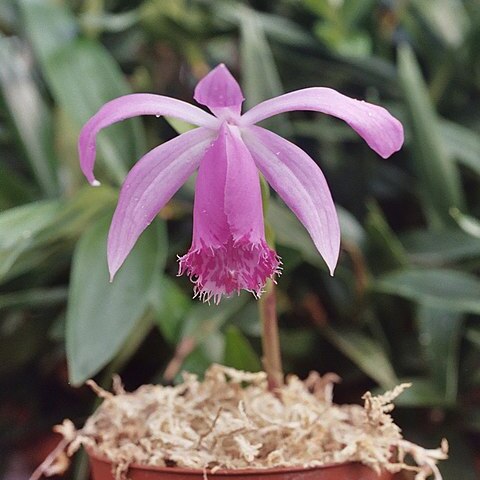Herbs, terrestrial or lithophytic. Pseudobulb ovoid to ovoid-conic, with a conspicuous neck, 1-2.5 × 1-2 cm, 1-leaved. Leaf immature at anthesis, developing after flowering, narrowly elliptic-lanceolate or suboblanceolate, 10-25 × 2-5.8 cm, papery, base attenuate into a petiole-like stalk 2-6.5 cm, apex acute or acuminate. Inflorescence erect; peduncle 7-20 cm, covered by 3 tubular sheaths below middle; floral bracts linear-oblong, (20-)30-40 mm, apex obtuse. Flowers solitary or rarely 2, pink to pale purple, with dark purple marks on lip; pedicel and ovary 10-25 mm. Dorsal sepal lanceolate to oblanceolate, 35-50 × 7-9 mm, apex acute or obtuse; lateral sepals narrowly elliptic or oblong-oblanceolate, slightly oblique, 35-50 × 8-10 mm, apex subacute or obtuse. Petals oblanceolate, slightly oblique, 35-50 × 4-7 mm, apex acute; lip obovate or broadly obovate when flattened, 35-45 × 30-40 mm, base cuneate and adnate to column, obscurely 3-lobed, apical margin lacerate; mid-lobe subquadrate, apex emarginate; disk with 4 or 5 erose lamellae 1-1.5 mm tall; central lamella (when present) usually shorter but taller than others. Column ± arcuate, 27-40 mm; column wings very narrow below middle, dilated above, 6-7 mm tall at apex, irregularly dentate. Capsule suboblong, 27-35 mm. Fl. Apr-Jun. 2n = 40*, 120*.
More
An orchid. It grows in soil or on rocks. The false bulb is oval with a neck. It is 1-2.5 cm long by 1-2 cm wide. There is one leaf. The leaf develops after flowering. It is narrowly oval and 10-25 cm long by 3-8 cm wide. It tapers into a leaflet like stalk 3-5 cm long. The flowers usually occur singly. They are pink to pale purple.

